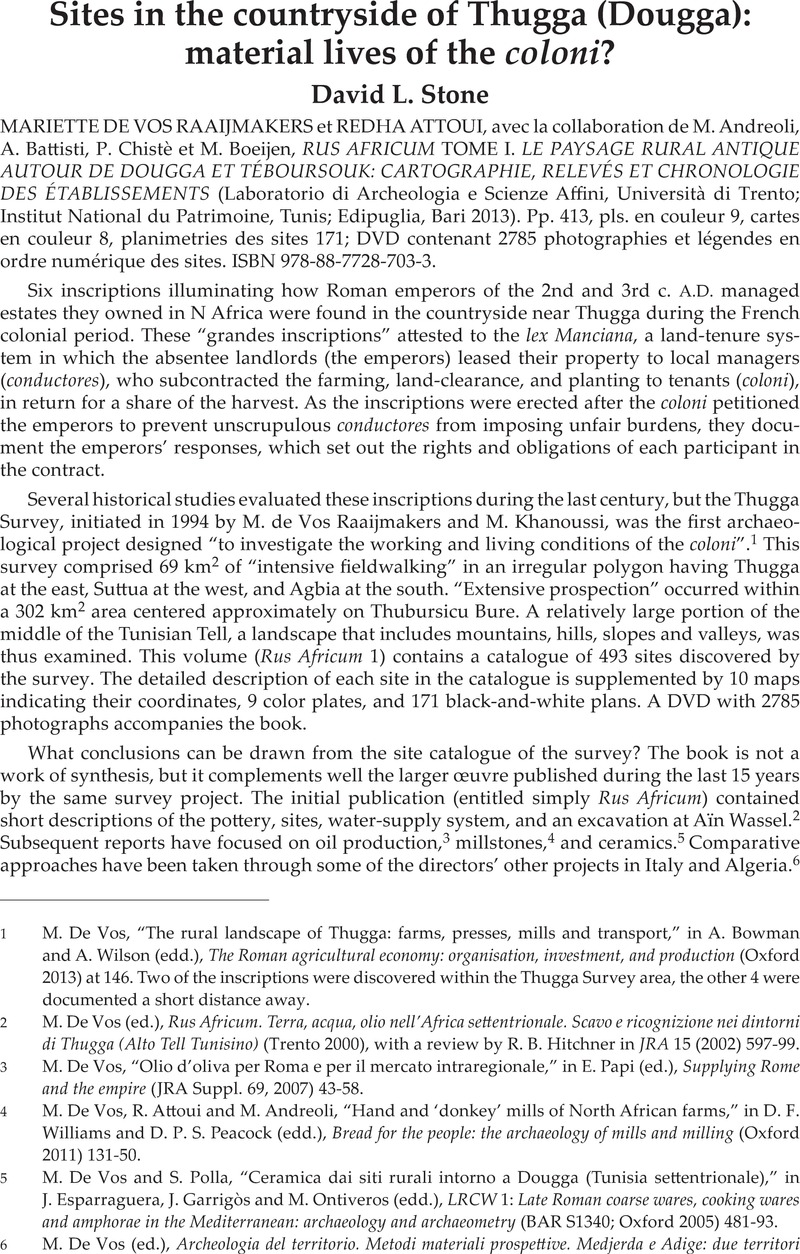No CrossRef data available.
Article contents
Sites in the countryside of Thugga (Dougga): material lives of the coloni? - MARIETTE DE VOS RAAIJMAKERS et REDHA ATTOUI, avec la collaboration de M. Andreoli, A. Battisti, P. Chistè et M. Boeijen, RUS AFRICUM TOME I. LE PAYSAGE RURAL ANTIQUE AUTOUR DE DOUGGA ET TÉBOURSOUK: CARTOGRAPHIE, RELEVÉS ET CHRONOLOGIE DES ÉTABLISSEMENTS (Laboratorio di Archeologia e Scienze Affini, Università di Trento; Institut National du Patrimoine, Tunis; Edipuglia, Bari 2013). Pp. 413, pls. en couleur 9, cartes en couleur 8, planimetries des sites 171; DVD contenant 2785 photographies et légendes en ordre numérique des sites. ISBN 978-88-7728-703-3.
Published online by Cambridge University Press: 27 November 2014
Abstract

- Type
- Reviews
- Information
- Copyright
- Copyright © Journal of Roman Archaeology L.L.C. 2014
References
1 De Vos, M., “The rural landscape of Thugga: farms, presses, mills and transport,” in Bowman, A. and Wilson, A. (edd.), The Roman agricultural economy: organisation, investment, and production (Oxford 2013) at 146 Google Scholar. Two of the inscriptions were discovered within the Thugga Survey area, the other 4 were documented a short distance away.
2 De Vos, M. (ed.), Rus Africum. Terra, acqua, olio nell'Africa settentrionale. Scavo e ricognizione nei dintorni di Thugga (Alto Tell Tunisino) (Trento 2000)Google Scholar, with a review by Hitchner, R. B. in JRA 15 (2002) 597–99Google Scholar.
3 De Vos, M., “Olio d'oliva per Roma e per il mercato intraregionale,” in Papi, E. (ed.), Supplying Rome and the empire (JRA Suppl. 69, 2007) 43–58 Google Scholar.
4 De Vos, M., Attoui, R. and Andreoli, M., “Hand and ‘donkey’ mills of North African farms,” in Williams, D. F. and Peacock, D. P. S. (edd.), Bread for the people: the archaeology of mills and milling (Oxford 2011) 131–50Google Scholar.
5 De Vos, M. and Polla, S., “Ceramica dai siti rurali intorno a Dougga (Tunisia settentrionale),” in Esparraguera, J., Garrigòs, J. and Ontiveros, M. (edd.), LRCW 1: Late Roman coarse wares, cooking wares and amphorae in the Mediterranean: archaeology and archaeometry (BAR S1340; Oxford 2005) 481–93Google Scholar.
6 De Vos, M. (ed.), Archeologia del territorio. Metodi materiali prospettive. Medjerda e Adige: due territori a confronto (Trento 2003)Google Scholar; Attoui, R. (ed.), When did antiquity end? Archaeological case studies in three continents (Oxford 2011)Google Scholar.
7 Raaijmakers, M. De Vos, Attoui, R. and Battisti, A., Rus Africum 2. Le paysage rural antique autour de Dougga: l'aqueduc Aïn Hammam-Thugga, cartographie et relevés (Bari 2013)Google Scholar, reviewed in this issue by Ph. Leveau.
8 Segermes: Dietz, S., Sebaï, L. Ladjimi and Hassen, H. Ben (edd.), Africa Proconsularis. Regional studies in the Segermes valley of northern Tunesia [sic] I-II (Copenhagen 1995)Google Scholar; Ørsted, P., Carlsen, J., Sebaï, L. Ladjimi and Hassen, H. Ben (edd.), Africa Proconsularis. Regional studies in the Segermes valley of northern Tunisia III: historical conclusions (Copenhagen 2000)Google Scholar. Cillium: Hitchner, R. B., “The Kasserine Archaeological Survey, 1982-86,” AntAfr 24 (1988) 7–41 CrossRefGoogle Scholar; id., “The Kasserine Archaeological Survey, 1987,” AntAfr 26 (1990) 231-60. Mididi: Baaziz, S. Ben, Rohia et le Sraa Ouertane dans l’Antiquité (Tunis 2000)Google Scholar. The phrase is Hitchner’s in id., “Historical text and archaeological context in Roman North Africa: the Albertini tablets and the Kasserine survey,” in D. Small (ed.), Methods in the Mediterranean: historical and archaeological views on texts and archaeology (Leiden 1995) at 133.
9 Kehoe, D., The economics of agriculture on Roman imperial estates in North Africa (Göttingen 1988)CrossRefGoogle Scholar; Hitchner, R. B., “Olive production and the Roman economy: the case for intensive growth in the Roman Empire,” in Amouretti, M.-C. and Brun, J.-P. (edd.), La production du vin et de l’huile en Méditerranée (Athens 1993) 499–508 Google Scholar; D. J. Mattingly, “Africa, a landscape of opportunity?” in id. (ed.), Dialogues in Roman imperialism (JRA Suppl. 23, 1997) 117-39; Stone, D. L., “Culture and investment in the rural landscape: the North African bonus agricola ,” AntAfr 34 (1998) 103–13CrossRefGoogle Scholar.
10 See also De Vos (supra n.1) 154.
11 The first article published by the Thugga Survey considered rural inscriptions: De Vos, M., “Gli antichi insediamenti rurali nei dintorni di Dougga e il riciclaggio delle epigrafi,” in Khanoussi, M. and Maurin, L. (edd.), Dougga (Thugga). Études épigraphiques (Paris 1997) 201–6Google Scholar. Subsequent work has made this outdated, and a new overview would be desirable. The most notable early work on rural epigraphy near Thugga was by Carton, L., Découvertes épigraphiques et archéologiques faites en Tunisie (région de Dougga) (Paris 1895)Google Scholar.
12 De Vos (supra n.1) 193-95, suggests confiscation by either Claudius or Nero in A.D. 53 or 66 (cf. Tac., , Ann. 12.59)Google Scholar.
13 Evidence for assigning sites to the chronological table derives from the typology of finds (pottery, glass, inscriptions, buildings, tombs); the last three are discussed in the present volume, but further precision must await the detailed publication of the pottery.
14 Cf. supra nn. 2, 4 and 5. Only a small percentage of the artefacts collected during fieldwalking has been published in the previous reports.
15 Dossey, L., Peasant and empire in Christian North Africa (Berkeley, CA 2010) 31–97 CrossRefGoogle Scholar.
16 Cf. supra n.8.




